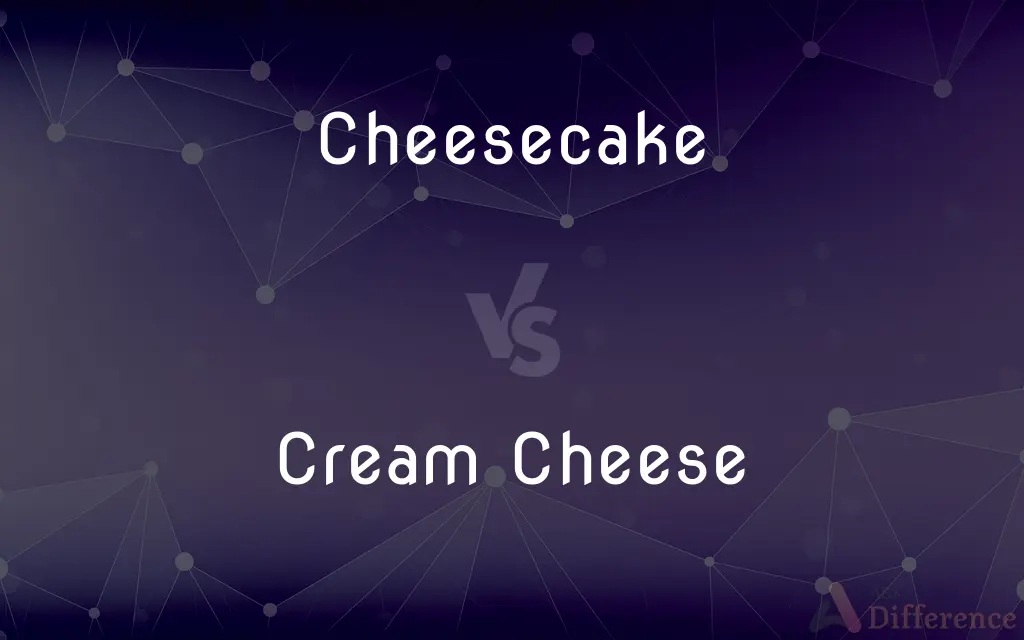Cheesecake vs. Cream Cheese — What's the Difference?
By Tayyaba Rehman — Published on October 23, 2023
Cheesecake is a sweet dessert made primarily with cream cheese, while cream cheese is a soft, mild-tasting cheese spread used in various dishes.

Difference Between Cheesecake and Cream Cheese
Table of Contents
ADVERTISEMENT
Key Differences
Cheesecake is a delectable dessert often enjoyed by many, made chiefly from a mixture that prominently features cream cheese. Cream cheese, in contrast, stands as a versatile dairy product that has a soft texture and a mildly tangy flavor, making it suitable for both sweet and savory applications.
Cheesecake's primary attribute is that it's a fusion of flavors and textures, often having a crumbly base, creamy filling, and sometimes a topping like fruit or chocolate. Cream cheese, on the other hand, is a simple, unadulterated product used as the foundational ingredient in many recipes, including cheesecake.
One could find cheesecake in bakeries, dessert menus, or celebrations, speaking to its position as a dessert staple. Cream cheese frequently graces breakfast tables, spread on bagels or toast, and is equally significant as an ingredient in numerous recipes ranging from dips to pastries.
To make a classic cheesecake, a generous amount of cream cheese is mixed with sugar, eggs, and other ingredients to achieve its characteristic rich and creamy consistency. In contrast, cream cheese production involves curdling milk and cream together, then draining off the whey to obtain its distinct creamy texture.
The beauty of cheesecake lies in its adaptability, allowing for variations with additions like chocolate, berries, or even caramel. Cream cheese doesn't just confine itself to cheesecakes; its application is diverse, finding its way into frostings, fillings, and even savory dishes.
ADVERTISEMENT
Comparison Chart
Nature
A dessert.
A dairy product.
Primary Ingredient
Contains cream cheese.
Is itself the product.
Usage
Eaten as a sweet treat.
Used in cooking and as a spread.
Texture and Consistency
Firm yet creamy.
Soft and spreadable.
Common Pairings
Fruit toppings, chocolate.
Bagels, bread, cakes, dips.
Compare with Definitions
Cheesecake
A sweet dessert with a creamy filling and crumbly base.
I ordered a slice of blueberry cheesecake at the cafe.
Cream Cheese
A cheese made by curdling milk and cream.
Cream cheese gives the dip its velvety texture.
Cheesecake
A rich cake with layers, often including a crust and toppings.
The chocolate cheesecake was a hit at the party.
Cream Cheese
A soft, mild-tasting cheese spread.
I spread cream cheese on my morning bagel.
Cheesecake
A creamy cake, often chilled, serving as a popular dessert.
The cheesecake's velvety texture made it a favorite among guests.
Cream Cheese
A dairy product with a creamy texture, used in cooking.
The frosting's creaminess comes from the added cream cheese.
Cheesecake
A culinary delight often featuring fruit or flavored toppings.
The strawberry glaze on the cheesecake was divine.
Cream Cheese
A white cheese spread, popular in both sweet and savory dishes.
The pastry had a delightful cream cheese filling.
Cheesecake
A dessert made primarily from cream cheese, sugar, and eggs.
The lemon zest gave the cheesecake a refreshing tang.
Cream Cheese
A tangy, soft cheese often used as a base in desserts.
This recipe requires two blocks of cream cheese.
Cheesecake
A cake made of sweetened cottage cheese or cream cheese, eggs, milk, sugar, and flavorings.
Cheesecake
The women depicted in such images.
Cheesecake
A pie made of sweetened and flavoured cottage cheese or cream cheese, eggs and milk on a crunchy base.
Cheesecake is an especially delicious dessert.
Cheesecake
A pie made of cream, eggs and milk (somewhat resembling the modern American chess cake).
Cheesecake
Made with sweetened cream cheese and eggs and cream baked in a crumb crust
Cheesecake
A photograph of an attractive woman in minimal attire
Common Curiosities
What's the main component of cheesecake?
The main component of cheesecake is cream cheese.
Is cheesecake always sweet?
While cheesecake is typically sweet, there are savory versions as well.
What dishes commonly feature cream cheese besides cheesecake?
Cream cheese is used in frostings, dips, pastries, and many other recipes.
Can cream cheese be consumed on its own?
Yes, cream cheese can be spread on bread or bagels and eaten directly.
Is cream cheese tangy?
Yes, cream cheese has a mildly tangy flavor.
How is the consistency of cheesecake?
Cheesecake has a firm yet creamy consistency.
Can cream cheese be flavored?
Yes, there are varieties of cream cheese with added flavors like herbs, fruits, or spices.
What gives cream cheese its soft texture?
Cream cheese gets its texture from the curdling of milk and cream and the removal of whey.
Can cheesecake have other flavors besides the traditional one?
Yes, cheesecake can come in a variety of flavors like chocolate, berry, or caramel.
Is cheesecake always baked?
No, there are no-bake versions of cheesecake as well.
Are there variations of cheesecake based on regions or countries?
Yes, there are various regional cheesecake versions like New York-style or Japanese cheesecake.
Can you use cream cheese in savory dishes?
Absolutely, cream cheese is versatile and can be used in both sweet and savory dishes.
How is the base of a cheesecake typically made?
The cheesecake base is often made from crushed cookies or graham crackers.
How is cream cheese typically packaged?
Cream cheese is often sold in blocks or tubs.
Is cream cheese high in fat?
Yes, cream cheese is typically high in fat, giving it a rich and creamy texture.
Share Your Discovery

Previous Comparison
Secure vs. Safe
Next Comparison
Director vs. Executive DirectorAuthor Spotlight
Written by
Tayyaba RehmanTayyaba Rehman is a distinguished writer, currently serving as a primary contributor to askdifference.com. As a researcher in semantics and etymology, Tayyaba's passion for the complexity of languages and their distinctions has found a perfect home on the platform. Tayyaba delves into the intricacies of language, distinguishing between commonly confused words and phrases, thereby providing clarity for readers worldwide.













































